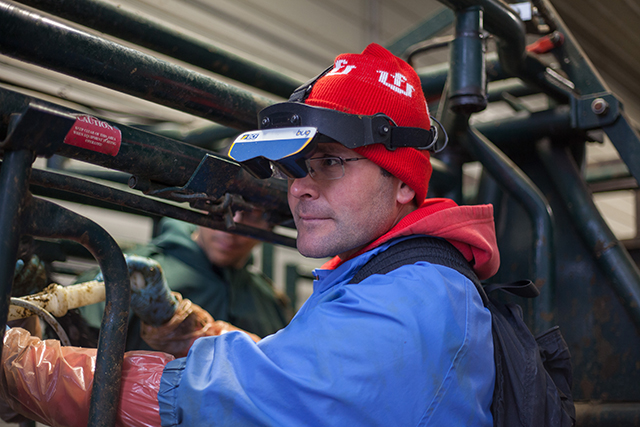
Teamwork will bring better health to cattle
Dr. Nathan Erickson wants to breathe new life into cattle disease control — literally.
By HenryTye GlazebrookErickson is an assistant professor in the Western College of Veterinary Medicine's Department of Large Animal Clinical Sciences. His work specializes in exploring new routes toward controlling widespread disease in the cow-calf and feedlot industries.
Bovine respiratory disease (BRD) — the most common and costly disease affecting beef cattle across the world — is just one such ailment that he’s working to curtail. While the illness typically occurs in calves after weaning, some cow-calf operation experience outbreaks of BRD before weaning. Clinical signs include depression, coughing and a lack of appetite — all of which can lead to death.
Erickson’s research focuses on providing veterinarians with information that will help them develop the most effective vaccination strategies for their clients. “I also hope that by finding the most effective vaccine strategies, we as an industry will be able to more effectively control diseases, such as bovine respiratory disease.”
This goal is where the University of Saskatchewan’s new Livestock and Forage Centre of Excellence (LFCE) becomes vital. This unique complex of field and science laboratories will bring together all aspects of beef cattle research, from students and those conducting studies right through to producers and industry partners.
For Erickson, a centre like this will provide him with the resources he needs to keep more calves from falling ill with BRD — and ultimately decreasing the number of losses faced by producers. Erickson wants to organize and conduct clinical trials for various vaccination strategies that focus on preventing BRD.
While there are many forms of vaccines commercially available, little to no large-scale clinical work has been done to show the effectiveness of these vaccines in the field. “The LFCE may potentially provide a large enough herd of cattle to conduct these trials on, as they require large numbers of animals,” says Erickson.
The use of antibiotics has played a key role in reducing the effect of BRD in the beef production system, but Erickson stresses that shifts in public perception have made his area of research increasingly important.
“With growing public scrutiny over antibiotic use and the development of resistance, it is important that we find methods to manage BRD without relying as much on antibiotics. We should strive to shift our use of antibiotics away from prevention and towards use for treatment,” he says.
He also emphasizes the exciting possibilities that simply having a large herd, such as what would be provided by the LFCE, closer to the university feedlot.
“The trials I am proposing look at preparation of the calves’ immune systems from birth to the first 60 days on feed. I would like to observe what vaccine program, begun during calfhood, will best prepare a calf for its highest period of disease pressure, which is during the first 30 to 60 days on feed.”
It’s the LFCE’s focus on collaboration that Erickson is anticipating with greatest enthusiasm. In a world of research that can often be quite isolated, the LFCE will create opportunities between colleagues, departments and organizations that will lead to more thorough planning, greater success in studies and better work overall.
“Good calf health is more than just disease control. The health of calves relies on a combination of nutrition, environment and disease control strategies. Focusing solely on one factor will not result in a healthy herd, just as researching one factor will not result in good research,” Erickson says.
“Good research relies on collaboration and sharing knowledge between both veterinarians and animal scientists. We should be able to accomplish this at the LFCE.”
As the LFCE moves steadily closer to becoming a reality and part of the university’s research structure, Erickson says he believes it could carve out a foothold for the university in beef research on an international scale.
“If all the different stakeholders can collaborate, there is great potential for this facility to become a premier beef research facility in North America.”
